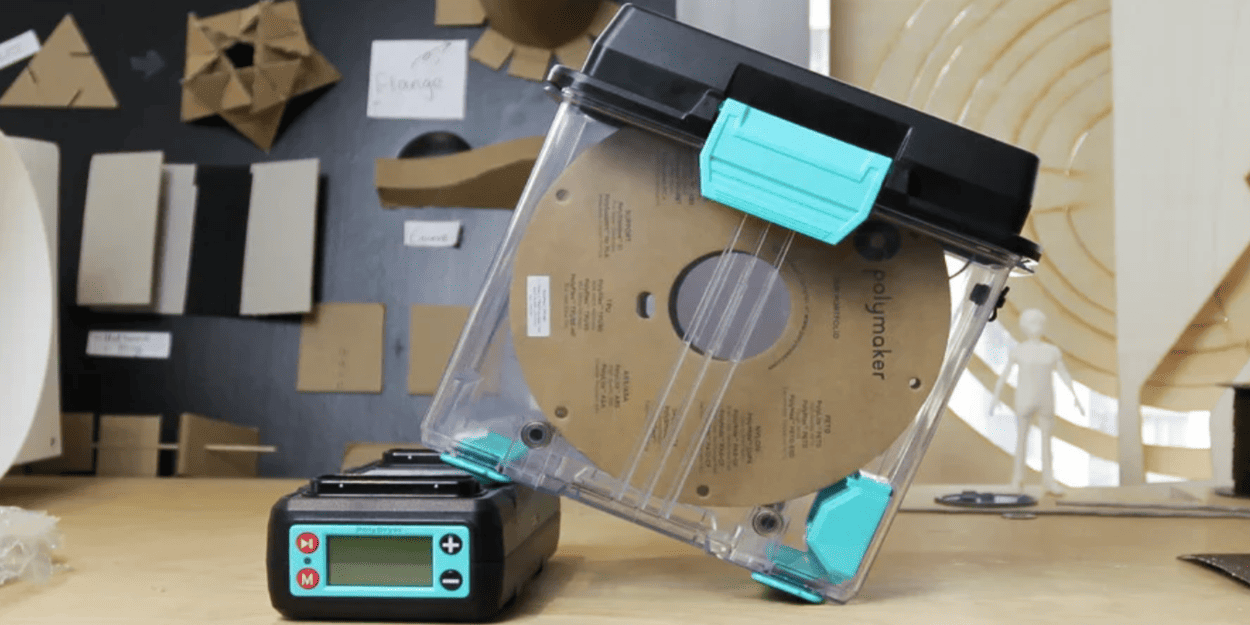Banner Image Courtesy of MatterHackers
Proper filament storage is one of the most overlooked aspects of 3D printing, yet it directly impacts print quality, reliability, and material lifespan. Even premium filament will produce poor results if it has absorbed moisture, been exposed to UV light, or collected dust.
Key Environmental Factors to Control
1. Moisture (Humidity)
Most thermoplastics are hygroscopic; they absorb water from the air.
Moisture-laden filament can cause:
Bubbling and popping during extrusion.
Poor layer adhesion.
Rough or stringy surfaces.
Solution: Store filament in an environment with <20% relative humidity for moisture-sensitive materials like Nylon, PVA, and TPU.
2. Temperature
High or fluctuating temperatures accelerate material degradation.
Solution: Keep filament in a cool, stable environment (15–25 °C / 59–77 °F). Avoid hot garages or rooms with direct sunlight.
3. UV Light Exposure
UV light can discolor, weaken, and embrittle plastics such as PLA and ABS.
Solution: Store in opaque containers or inside a closed cabinet away from direct sunlight.
4. Dust and Contaminants
Dust on the filament can clog nozzles and affect extrusion flow.
Solution: Keep spools sealed in bags or containers. Use filament dust filters during printing for added protection.
Filament-Specific Storage Needs
|
Humidity Sensitivity |
Special Notes |
|
|
Low to moderate |
Store in sealed bag; protect from UV to prevent brittleness. |
|
|
Moderate |
Avoid high humidity; can become sticky if stored in heat. |
|
|
Low |
Protect from UV; otherwise stable in sealed container. |
|
|
Low |
UV-resistant but still benefits from sealed storage. |
|
|
Very high |
Requires aggressive moisture control; dry before use. |
|
|
PVA |
Extremely high |
Store in vacuum bag with fresh desiccant; short shelf life once opened. |
|
Moderate to high |
Avoid sharp bends; keep dry to prevent extrusion issues. |
|
|
Carbon Fiber & Composite |
Depends on base material |
Store as you would the base polymer; protect spool edges from damage. |
Storage Solutions
1. Vacuum-Sealed Bags with Desiccant
Inexpensive and space-saving.
Use with silica gel packs to absorb moisture.
Works well for hobbyists with a small filament collection.
2. Airtight Plastic Containers
Options: food storage bins with gasket seals, stackable storage boxes.
Add a reusable humidity indicator card to monitor moisture levels.
3. Filament Dry Boxes (Passive)
Commercial products designed to store and feed filament directly to the printer.
Keep spools dry during long prints.
4. Active Filament Dryers
Use low heat and air circulation to maintain dryness during printing.
Ideal for Nylon, PVA, and other highly hygroscopic filaments.
5. DIY Solutions
Repurpose food dehydrators, airtight pet food containers, or modified coolers.
Combine with a rechargeable desiccant for low-cost, effective storage.
How to Dry Filament
When to Dry Filament
• You hear popping or hissing during printing.
• Prints show poor adhesion, excessive stringing, or rough textures.
• The spool feels heavier or tacky.
Drying Methods
|
Method |
Recommended Temp Range |
Pros |
Cons |
|
Filament Dryer Box |
40–60 °C |
Purpose-built, safe, consistent results |
Extra cost |
|
Food Dehydrator |
40–50 °C |
Affordable, effective |
Limited spool size |
|
Convection Oven |
40–50 °C |
Works if careful, larger capacity |
Risk of overheating; requires monitoring |
Drying Times (General Guide):
• PLA: 4–6 hours at 45 °C
• PETG: 4–6 hours at 65 °C
• ABS: 2–4 hours at 80 °C
• Nylon: 6–12 hours at 70 °C
FAQs
Q: How long can filament be stored?
A: Unopened, vacuum-sealed filament can last 2+ years. Opened spools last month to a year, depending on storage quality.
Q: Does PLA really need a dry box?
A: PLA is less hygroscopic than Nylon, but benefits from low-humidity storage, especially in humid climates.
Q: Can I reuse desiccant packs?
A: Yes, most silica gel packs can be “recharged” by heating them in the oven at 120 °C for 1–2 hours.
Q: Can filament be damaged beyond repair?
A: Yes, if it becomes too brittle or loses structural integrity. Some old or degraded filament is best discarded.
Q: Is it safe to dry filament in a regular oven?
A: Only if it has a reliable low-temperature setting and you monitor it closely. Some ovens fluctuate and may overheat.














